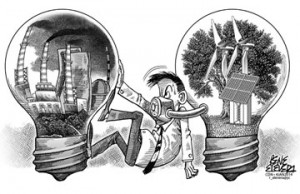Clean energy

Fury mentioned an energy race kick-started by Stark’s father Harold Stark and his former Russian ally Anton Vanko with the discovery of an arc reactor that would provide clean, nearly limitless energy for the world.
The promise of clean, sustainable, energy, continues to inspire and bedevil the world’s scientific community, which still dreams of a source that would make the “atomic bomb look like a triple A battery” to borrow Fury’s words.
High power rates to be charged by Meralco on Luzon consumers serve as a warning to Visayas consumers as well, who are already suffering rotation brownouts because of the double whammy caused by the Oct. 15 earthquake and November’ s supertyphoon Yolanda.
Solar energy is cheap and available nearly all year round, but solar panels aren’t, even if they are commercially available.
The cheapest set made in China costs more than P15,000 and can only collect energy sufficient to power light bulbs.
Article continues after this advertisementIn the aftermath of Yolanda, mass outages in the Visayas were the result of damaged transmission lines and plants in Leyte, and toppled power poles across the region, including Cebu, a situation that will take at least a year to fix.
Article continues after this advertisementAffluent families and business enterprises turn to standby generators, but operating them is not cheap.
The fuel need to maintain a household’s power consumption, more so a commercial establishment, is a drain on the pocket. Companies may have contingency funds that the average Filipino family doesn’t but industries will eventually pass on the cost of the emergency power to consumers in the prices of goods and services.
Ecology advocacy groups argue correctly that developing and using environment-friendly, clean energy sources is best for the long term than sticking with dirty coal and fossil fuel.
But here we are, in a crisis of immediate needs competing for a limited resource.
The challenge remains to develop infrastructure and technology to maximize the use of clean energy as the primary source for homes and industries, without digging ourselves in a deeper hole by exploiting more fossil fuel sources that have contributed to climate change over the past decades.
An even bigger challenge remains tempering greed in the consumption of energy by big-scale users and the irresponsible use of electric power by an ever growing population.